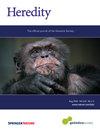Forest tree breeding using genomic Markov causal models: a new approach to genomic tree breeding improvement
IF 3.9
2区 生物学
Q2 ECOLOGY
引用次数: 0
Abstract
Traditionally, a pedigree-based individual-tree mixed model (ABLUP) has been used in forest genetic evaluations to identify individuals with the highest breeding values (BVs). ABLUP is a Markovian causal model, as any individual BV can be expressed as a linear regression on its parental BVs. The regression coefficients are based on the genealogical parent-offspring relationship and are equal to one-half. This study aimed to develop and apply two new causal models that replace these fixed coefficients with ones calculated using genomic information, specifically derived from the genomic-based relationship matrix. We compared the performance of these genomic-based causal models with ABLUP and non-causal GBLUP models. To do so, we evaluated a four-generation population of Eucalyptus grandis, consisting of 3082 genotyped trees with 14,033 single nucleotide polymorphism markers. Six traits were assessed in 1219 trees across the first three breeding cycles. The heritability and genetic means estimates were higher in the causal pedigree- and genomic-based models compared to GBLUP. Realized genetic gains were similar across all models, but the causal models more closely matched the predicted gains than GBLUP. In turn, GBLUP demonstrated better predictive performance, albeit with lower precision. The causal models developed in this study enable discerning intra-familial variations in the predictions of BVs at a lower computational burden and offer a potential alternative to the GBLUP model.

利用基因组马尔可夫因果模型进行林木育种:基因组林木育种改进的新途径。
传统的森林遗传评价采用基于家系的个体-树混合模型(ABLUP)来鉴定具有最高育种价值的个体。ABLUP是一个马尔可夫因果模型,因为任何个体的BV都可以表示为其亲本BV的线性回归。回归系数以亲代关系为基础,等于1 / 2。本研究旨在开发和应用两种新的因果模型,用基因组信息(特别是基于基因组的关系矩阵)计算的因果模型取代这些固定系数。我们将这些基于基因组的因果模型与ABLUP和非因果GBLUP模型的性能进行了比较。为此,我们评估了一个由3082棵基因型树和14033个单核苷酸多态性标记组成的四代大桉树群体。在前三个育种周期对1219棵树的6个性状进行了评估。与GBLUP相比,基于因果谱系和基因组模型的遗传率和遗传均值估计更高。所有模型中实现的遗传收益相似,但因果模型比GBLUP模型更接近预测收益。反过来,GBLUP显示出更好的预测性能,尽管精度较低。本研究中建立的因果模型能够在较低的计算负担下识别bv预测中的家族内变异,并为GBLUP模型提供了一个潜在的替代方案。
本文章由计算机程序翻译,如有差异,请以英文原文为准。
求助全文
约1分钟内获得全文
求助全文
来源期刊

Heredity
生物-进化生物学
CiteScore
7.50
自引率
2.60%
发文量
84
审稿时长
4-8 weeks
期刊介绍:
Heredity is the official journal of the Genetics Society. It covers a broad range of topics within the field of genetics and therefore papers must address conceptual or applied issues of interest to the journal''s wide readership
 求助内容:
求助内容: 应助结果提醒方式:
应助结果提醒方式:


